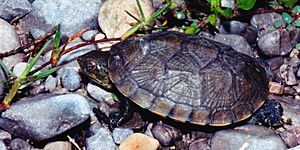Mexican mud turtle facts for kids
Quick facts for kids Mexican mud turtle |
|
|---|---|
 |
|
| A young Mexican mud turtle (Kinosternon integrum) from Tamaulipas, Mexico. | |
| Conservation status | |
| Scientific classification | |
| Genus: |
Kinosternon
|
| Species: |
integrum
|
| Synonyms | |
|
|
The Mexican mud turtle (Kinosternon integrum) is a type of mud turtle. It belongs to the Kinosternidae family. This turtle is only found in Mexico. You can find it in many Mexican states, including Aguascalientes, Colima, Durango, Guanajuato, Guerrero, Hidalgo, Jalisco, Michoacán, México, Morelos, Nayarit, Oaxaca, Puebla, Queretaro, San Luis Potosí, Sinaloa, Sonora, Tamaulipas, and Zacatecas. They like wet places such as shallow ponds, lakes, and rivers. They also live in warm, tropical forest areas.
Reproduction and Life Cycle
The Mexican mud turtle's nesting season is from early May to September. This time starts just before the summer rainy season. A female turtle usually lays 2 to 4 eggs at a time. However, she can lay anywhere from 1 to 8 eggs.
There is a small difference between male and female turtles. Females have nostrils that are more rounded. Their nostrils are also more brownish in color. Male turtles, on the other hand, have yellowish nostrils.
What Mexican Mud Turtles Eat
Mexican mud turtles are omnivores. This means they eat both plants and animals.
- Plants they eat:
* Filamentous algae (a type of pond scum) * Grass seeds * Guava seeds * And other plant materials
- Animals they eat:
* Ants * Wasps * Bees * And other small creatures
During the dry seasons, female turtles tend to eat more plants than males do.


